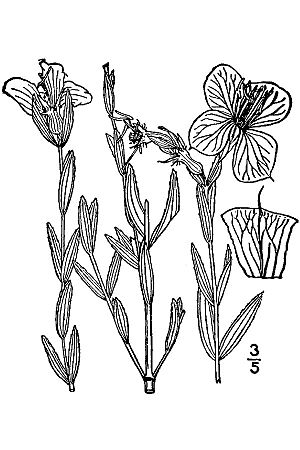Awned meadowbeauty facts for kids
Quick facts for kids Awned meadowbeauty |
|
|---|---|
 |
|
| 1913 illustration | |
| Conservation status | |
| Scientific classification | |
| Genus: |
Rhexia
|
| Species: |
aristosa
|
Rhexia aristosa, also known as the awned meadowbeauty or awnpetal meadowbeauty, is a type of flowering plant. It belongs to the Melastomataceae family. This plant grows naturally in the eastern United States. You can find it in the coastal plain areas, stretching from New Jersey all the way to Alabama.
Contents
Awned Meadowbeauty: A Special Wetland Plant
The awned meadowbeauty is a unique plant that thrives in wet places. It's known for its pretty flowers and its ability to grow in challenging environments.
What Does It Look Like?
This plant is a perennial herb, which means it lives for more than two years. It has stiff stems that can grow quite tall, usually between 70 to 100 centimeters (about 2.3 to 3.3 feet) high. Its leaves are long and narrow, shaped like a spear, and can be up to 5 centimeters long. The flowers are a lovely lavender color. Each petal can be up to 2 centimeters long. You can see these flowers blooming from June through September.
Where Does It Grow?
The awned meadowbeauty loves wetland areas. These are places where the land is covered by water, either all the time or for part of the year. It grows in several types of wetlands, including:
- Bays: These are often low, wet areas.
- Bogs: Wet, spongy areas with lots of peat.
- Flatwoods: Flat, wooded areas that can be wet.
- Seasonally moist pools and meadows: Places that get wet during certain times of the year.
- Savannas: Grasslands with scattered trees.
It is often found in special wetlands called Carolina bays. These are oval-shaped depressions in the land. The plant can grow under Pond cypress trees. It often shares its home with other plants like Panicum hemitomon, Polygala cymosa, Lobelia boykinii, Sagittaria species, and Lachnanthes caroliniana. This plant is very tough. It can handle natural events like wildfire and flooding.
Why Is It Important to Protect This Plant?
The awned meadowbeauty is facing challenges. Its natural home is shrinking. This happens when wetlands, like Carolina bays, are changed for other uses. For example, they might be turned into farms or tree plantations (called silviculture).
When land is developed, the natural water flow (called hydrology) can change. This can dry up natural springs. It can also cause polluted runoff to flow into the wetlands. Trees are also sometimes cut down in these areas, which changes the environment. Protecting these wetlands helps keep the awned meadowbeauty and many other plants and animals safe.
See Also


